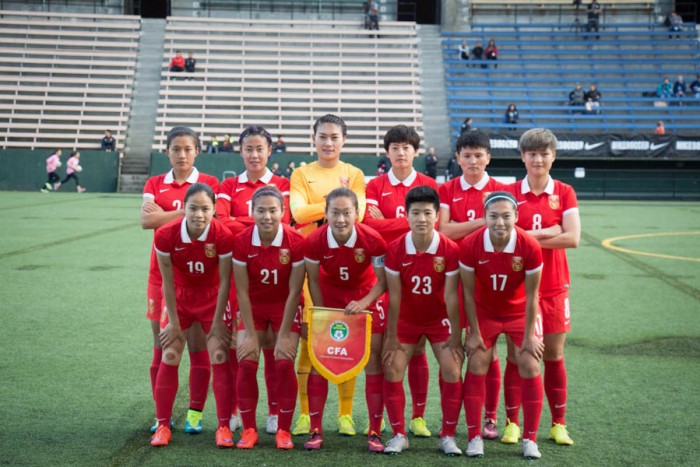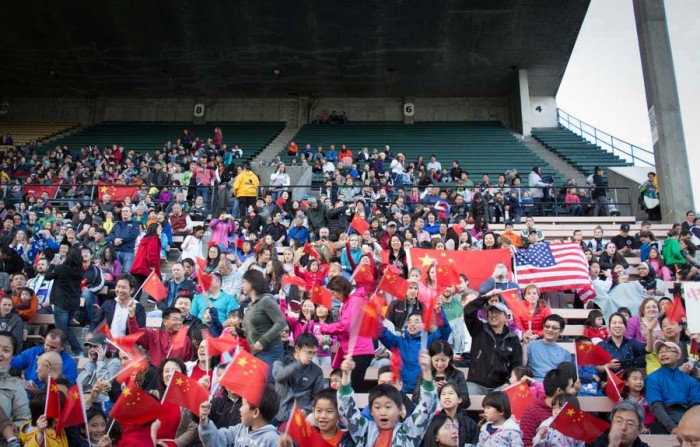
Friday’s exhilarating game between Seattle Reign FC and the China women’s national soccer team ended up with a 1-1 draw at Seattle’s Memorial Stadium.
At 36 minutes, midfielder Guixin Ren scored a long shot for China. In the second half, Beverly Yanez headed a goal for Seattle Reign at 48 minutes. Women’s soccer fans showed up 4,021 strong for both teams at the stadium Friday night, and as someone Chinese, I was proud to see so many Seattle Chinese nationals waving their China flags in the crowd.
This game was noteworthy for both teams, sending off Seattle Reign goalkeeper Hope Solo and forward Megan Rapinoe, to compete in the World Cup on the U.S. women’s soccer team, and marking China’s team’s first warm-up game in preparation for the World Cup outside of China this year.
With these milestones and more progress, both U.S. and China national women’s soccer teams appear to be bouncing back from years of institutional pitfalls.
The thrill of Friday’s game reminded me of my very first impression of women’s soccer in 1999. I was 6, staying up late with my parents to watch the World Cup final between China and the U.S.

It was a golden moment for China’s soccer, prefacing more games where the women’s national team made it to the World Cup finals in 2003 and 2007, and when China’s men’s national team made their first appearance at the World Cup in 2001. The U.S. women’s national team was at their height as well, winning the 1999 World Cup.
Women’s soccer in both countries, however, have suffered a series of clear setbacks since then.
The National Women’s Soccer League (NWSL) — the league that Seattle Reign is currently a part of — is the U.S.’s third women’s soccer league. Both Women’s United Soccer Association (WUSA), which operated from 2000 to 2003, and Women’s Professional Soccer League (WPSL) existing from 2009 to 2012, folded within five years due to disorganization, high expenses and low sponsorships and legal issues.
A spiral of funding problems that plagued U.S. and China teams since 1999 are reflected in World Cup results: the U.S. women’s national team hasn’t won the championships after 1999, and China’s women’s team couldn’t even make an appearance at the 2011 World Cup.
In China, it is hard to recruit young players in many clubs because many young athletes are low-income, and seeking a more economically secure life.
Low salaries make up a major source of this of this regression for China’s women’s national team. According to a 2014 Tencent news report, the salary of China’s female soccer players even in the highest division were quite low. The players from the clubs in big cities like Shanghai can have an average monthly salary of 5,000 renminbi (around $800). On some teams, the monthly salary was lower than 600 renminbi (around $160), and the players from the lowest divisions may make only 600 renminbi (around $96) or less per month.

The NWSL is in a much better place, but still recovering in the shadow of past institutional failures. Due to the administrative flops of WUSA and WPSL, NWSL has imposed strict control on the player’s salaries, which, this year, range from $6,842 to $37,800 for the season, according to a recent Equalizer report.
Though salaries are large in comparison to China’s, the U.S.’s low pay relative to itself also limits recruitment of players with more experience.
On the whole, though, Bill Predmore, owner of Seattle Reign FC, thinks the league is getting better.
“For the funding of this league, all of the owners, we are all very focused on making sure that the [league’s] financial model was sustainable over the long term,” he said.
Predmore attributes part of this to keeping overhead low and revenue higher by bringing more fans to the stadium.
“Our focus has really been on putting a great product on the field, and then trying our best to get the word out,” he said. “Our belief is that if the quality of the product is great, that over time, people will hear about it. They will tell their friends. Over a period of many years, our fans will grow and grow and grow.”
The Seattle Reign FC has put a “significant focus” on digital marketing with promotional video series and social media outreach, the latter being a really low-cost way to promote the team, he said.
“We are trying to create a[n] … emotional connection between the players and fans — get the fans a chance to know the players on a deeper level, to build that bond,” Predmore explained.
On the Memorial Stadium field Friday night, I could definitely see that emotional connection.
The send-off ceremony for Solo and Rapinoe to compete in the World Cup earned tons of applause, and a lot of adoring, young fans were waiting beside the field after the game to have close contact with their idols.
China’s women’s soccer prospects might stand to improve as well with President Xi Jinping’s love of soccer potentially translating into greater investments in the country’s national soccer teams.
In March, the State Council, China’s cabinet, announced proposals to clean up the country’s soccer administration and expand soccer coaching to reach 50,000 schools and universities by 2025. Currently soccer education is only available at 5,000 middle and elementary schools throughout the country.
“More and more attention are paid to soccer right now,” said Haiyan Wu, captain of the Chinese WNT, during a post-game press conference on Friday. “More and more teenagers start to play on-campus right now, and the whole industry is developing. That may benefit us after we retire in the future.”
Yasha Gu, who plays for China’s women’s national team, sees this year’s World Cup as a major opportunity to keep the positive attention and direction going.
“We hope to have a great performance on such a big stage, so we can have more fans and young players in China,” she said at the press event.
Hopefully, more attention turns into more investment in China and U.S.’s women’s soccer. Though both industries continue to face economic challenges, the U.S. and China are trying to address these issues.
And from the initial looks of it, it appears they are on the right track.

